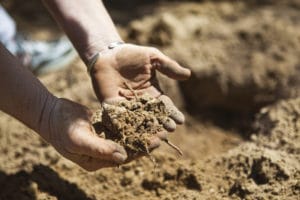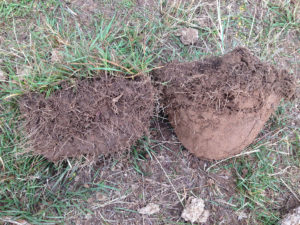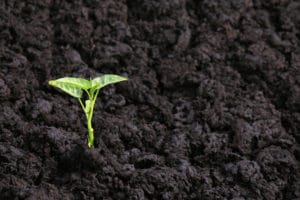Soil carbon’s role in creating healthy topsoil is becoming a global topic.
It’s a popular notion that humankind is contributing excessive amounts of carbon into the atmosphere in the form of greenhouse gas. There’s been debate on what can be done to correct this situation, going so far as to suggest methods of sequestering the carbon into places of long-term storage. Regardless of who’s right or wrong, it can’t be debated that the definition of a healthy topsoil is when the soil has a rich concentration of durable carbon compounds that change for the better the chemical, physical and biological nature of the soil.
I heard recently a Ph.D. horticulture specialist say that you cannot add too much compost to a soil and that compost was the key to building and preparing a soil. In fact, he published on his university’s letterhead a statement where he recommends adding as much as 6 cubic yards of compost to an area of 1,000 square feet while preparing the site for landscaping. I heard a similar statement was made at a Santa Fe nursery seminar by a guy who makes compost. Well, that statement may be true if the compost was still composed of extremely decay-resistant woody material that was also low in nutrients, but then it would not be compost.
The simple act of composting is where specialized fungi and bacteria called saprophytic microorganisms collaborate in the reduction (shrinkage) of organic matter by utilizing the calorie value of the fats, proteins and sugars contained in the organic matter. As the microbes eat, they are concentrating all the parts that cannot be eaten, such as the minerals and the humic substances (HS). If plentiful levels of oxygen are available, the microbes that need oxygen to function will do the composting. A bi-product of their work will be CO2 which the microbes liberated from the carbon that was part of the digestible (decomposable) organic matter — the proteins, the fats and the sugars (carbohydrates). We call this source of carbon “rapid cycling carbon,” as it simply will not persist in the soil as part of the long lasting carbon bank that defines a topsoil. The part of a topsoil that defines the very essence of the soil is the concentration of the carbon substance that is not rapid cycling, and which has a resonance time in the soil of thousands of years. These carbon molecules are powerful biologic chemicals of nature called humic acids (HA or HAs), which are contained within the whole material called humic substances. They are not food for microbes, fungi or bacteria, therefore, they are not decomposable and will persist for a long time. Compost is a poor source of these substances, which any commercial soil lab can verify by doing a humic acid extraction and assessment. Levels of 1 to 5 percent humic acid are typical of a high quality finished compost, which is insignificant and inadequate to expect compost to fulfill the objective of building soil carbon directly.

For this reason, you simply can’t add enough compost to make a difference without overdosing the soil with nutrients! This also makes the term humification in my opinion an obsolete term, since that term implies that composting (decomposition) of organic matter results in the formation and high concentration of humic substances, which it does not! If it did, we would see levels much higher than 5 or even 25 percent humic acid in commercial compost, which we rarely see unless the compost was salted (fortified) using humate/leonardite.
Soil Carbon and Compost
Carbon found within the molecular structures of proteins, fats and carbohydrates (sugars) is turned into CO2 when oxygen is plentiful and aerobic saprophytic microbes can do their work. If O2 is not plentiful, then only those microbes that can function anaerobically (without air) can do the decomposing. This is not good, because toxic chemical compounds are the byproduct of anaerobic organic matter decomposition.
Compounds such as lactic acid and alcohol are produced when oxygen is not available in adequate amounts and those chemicals are toxic to plants at even parts per million. Anaerobic metabolism can occur in our muscle tissue as well, when we are out of shape and have poor vascularity (blood flow) in the muscles. This causes poor gas exchange during exercise and the muscle cells will not have adequate levels of oxygen, resulting in the production and accumulation of lactic acid. The lactic acid is toxic and irritating to the cell walls of your muscles and nerve endings and you consequently will feel pain a day or two after you workout. So it doesn’t matter if we are talking about soil, or we are talking about our own bodies, we must have adequate amounts of oxygen at all times in order to have optimum health.

These two soils came from neighboring fields separated only by a fence. This Wyoming ranch recently converted half of the irrigated hay ground into pastures and implemented a rotational grazing system. The soil on the right is from the field that remained in hay production. The soil on the left is from the field that was converted to well managed pasture. Note the change in color (soil carbon) and rooting depth after only one year.
Soil Carbon and Compost Limits
So we don’t want compost that is produced without oxygen, but here’s the other side of the problem when we look back at the original statement “that you can’t add too much compost.”
You can indeed add too much compost, and for many reasons, one of which is back to the problem of oxygen. Here’s how and why; the more decomposable organic material you have, the more microbes will want to get into the act therefore, the more oxygen will be needed to accommodate this feeding frenzy. We call this the “BOD” or the Biological Oxygen Demand. If you incorporate into the soil too much compost that still contains a lot of combustible organic matter, the resulting population explosion of saprophytic microorganisms will rapidly use up the oxygen and your soils will go anaerobic. This results in a whole slew of unhealthy conditions, including the production of lactic acid and alcohol, two chemicals that are toxic to plant roots.
The other problem with adding too much compost is that if it is really compost and if it is made from a source of nutrient-dense plant organic matter, it will contain a rich and concentrated source of plant nutrients. After all, who do you know that is intentionally looking for a poor nutrient source of organic matter in order to make their compost? That would be silly, plus you may not achieve the proper carbon to nitrogen ratio needed to actually instigate the composting process. If you made the compost using the proper carbon to nitrogen ratio, by default your finished product will contain a significant amount of nitrogen. The bulk density of compost can easily be 40 to 50 pounds per cubic foot, which is 1080 to 1350 pounds per cubic yard. If you add 6 cubic yards of compost, as suggested by the University Ph.D. for a total of 7,800 to 8,000 pounds of compost per 1,000 square feet, you have also added over 103 to 106 pounds of nitrogen, a toxic amount! On a per acre level, that’s approximately 4,600 pounds of nitrogen, an amount that no farmer on earth would dare apply. So yes indeed, you can add too much compost!
As I’ve already described, the carbon found in over 95 percent of the carbon-rich parts of a compost are easily and rapidly decomposed into CO2, which defends my claim that compost is the wrong tool in the tool box, needed to accumulate carbon into the soil. The purpose of this tool is that it could potentially be a source of plant available nutrients if the composter was actively utilizing nutrient dense sources of plant organic matter.
As a fertilizer, compost can nutritionally support vegetation and it is then that we see a more efficient and effective development of topsoil, only because the plant is better at photosynthesis! If the plant is better at photosynthesis it can convert more atmospheric carbon into biological carbon called glucose, which is then transported down into the roots and provided to the bacteria and the mycorrhizal fungus. “Root Exudates” are liquid glucose leaking into the soil from the roots of plants.

Soil Carbon and Humus
In the same article, May 2011 issue of Discover Magazine, my 30-year long opinion of where humus comes from is finally collaborated by another source. Humus does not come from humification of dead organic matter; rather, it’s a result of an efficient mutualism between plants and the terrestrial biosphere of soil microorganism, and most specifically the mycorrhizal fungi. The mycorrhizal plant fungi relationship is critical to the process of pedogenesis, because it’s the massive contribution this fungus makes to its host plant in the form of water and minerals that allows the plant to be healthier and to live longer. Science has demonstrated that when a plant is mycorrhizal, the uptake of minerals from the soil is dramatically better and the drought tolerance of the plant is also significantly better.
Once again, a healthier and longer living plant can contribute more carbon in the form of liquid glucose to the soils terrestrial biosphere and from there everybody gets fed. Be clear that almost without exception, farm soils worldwide are lacking a strong mycorrhizal component therefore, expecting humus to accumulate in those same farm soils is most likely not going to happen. Also, research has proven that plants must have the benefit of this amazing fungus in order to get those minerals out of the ground in a useful fashion and with the minerals comes water. This is how we grow a nutrient-dense crop and also grow soil. For farming, mine reclamation, landscaping, highway re-vegetation, and other venues where you hope to build soils, you must inoculate with a mycorrhizal product, if you expect to see these benefits.
In 1974 I described this relationship as the “Soil Food Web,” a process of soil formation and collaboration, where most terrestrial life benefits from the Bio-Geo-Chemical process of mineral nutrient sequestering and availability. The term humus is one used by the average person, but its technical description used in chemistry is humic substance! The term humic substance describes a whole bunch of carbon rich compounds that resist decay and which are products of soil chemistry. Within the whole substance is a chemical of nature called humic acid. While humic acids are powerful chemicals with many characteristics and benefits, it’s the whole substance of humic compounds that are the major bank of long lasting carbon in the soil, resulting in the formation and accumulation of a rich topsoil.
But What About Soil Compaction?
The large, air-filled spaces, or “macropores,” in untilled soil without compaction, often resemble the branching vessels of the human circulatory system. A team of Nordic researchers led combined computed tomography (CT) scanning with traditional measurements of air exchange to “diagnose” the long-term impacts of soil compaction on the hidden, but vital, soil pore network. When scientists examined cores of heavy clay subsoil suffering from compaction on a research site in Finland, they found the macropores were greatly affected compared with a non-compacted control soil. The compacted soil contained mostly long, vertical “arterial” pores, or pipes, with significantly fewer marginal pores branching from them.
Most troubling to the researchers was how lasting the impacts of compaction appear to be. In the study, the group examined soil cores taken from a depth of 0.9 to 1.2 feet in plots where 30 years earlier a heavy tractor-trailer drove over the ground four times to create compaction in an experimental treatment.
It’s where a lot of farmers end up at some point, with dirt. And turning it into soil starts with understanding carbon.
By Michael Martin Meléndrez. This report on soil compaction appears in the April 2014 issue of Acres U.S.A. magazine. This story originally published in October 2011 issue of Acres U.S.A. magazine. Michael Martin Meléndrez and his wife Kari, own Soil Secrets LLC, Soil Secrets Worldwide LLC, and the Trees That Please Nursery. Contact Soil Secrets and Michael by calling 505 550-3246, or email soilsecrets@aol.com.

